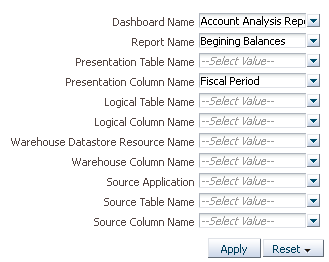About Performing Analysis with Data Lineage Dashboards
Data lineage is analyzed across a variety of Oracle BI Applications entities, using dashboard prompts for the details on the DataLineage Summary page of the OBIA DataLineage dashboard.
-
Dashboard Name
-
Report Name
-
Presentation Table Name
-
Presentation Column Name
-
Logical Table Name
-
Logical Column Name
-
Warehouse Datastore Resource Name
-
Warehouse Column Name
-
Source Application
-
Source Table Name
-
Source Column Name
You can select dashboard prompt values at any level, and subsequent selections are constrained by your other selections, so that, for example, if you have made a selection in the Report Name prompt, any selection from the Logical Table Name prompt will be limited to those included in the selected report.
The OBIA Data Lineage dashboard has five pages, including a summary whose tabular results can be drilled into for detailed lineage reports in detail pages. These pages include:
-
DataLineage Summary: Provides an end-to-end data lineage summary report for physical and logical relationships. To navigate to detailed reports and dashboard pages for an entity in the Summary report, click its link.
-
Dashboard Implementation: For a selected dashboard, provides reports detailing: dashboard pages, reports, and Presentation columns; Presentation catalog, tables, and columns; RPD implementation, detailing how a Presentation column is derived from a physical column in the OBAW.
-
Report Implementation: For a selected report, provides details on the derivation on the Presentation column from its underlying physical column. Also includes reports describing the warehouse tables, and listing the ODI interfaces and adaptors that load both from the OLTP source into the staging tables and from the staging tables into the warehouse dimension and fact tables.
-
Presentation Layer Implementation: For a selected Presentation table and column, provides details on the logical and physical column derivation in the RPD. Also includes reports describing the warehouse tables, and listing the ODI interfaces and adaptors that load both from the OLTP source into the staging tables and from the staging tables into the warehouse dimension and fact tables.
-
Warehouse Implementation: For a selected warehouse table name and column name, provides a summary of the warehouse data store and its OLTP source tables and columns. Also includes reports listing the ODI interfaces and adaptors that load both from the OLTP source into the staging tables and from the staging tables into the warehouse dimension and fact tables.
